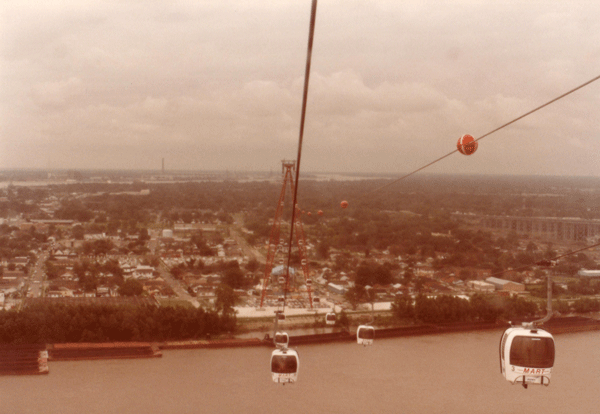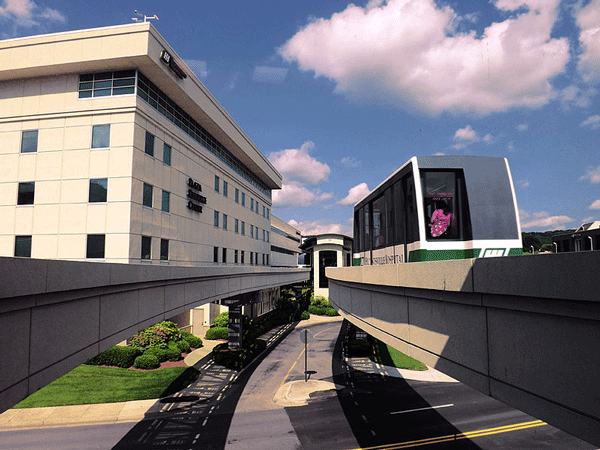
The ill-fated Mississippi Aerial Rapid Transit (MART). As an aside, it ranks as one of the worst names you can have for a transit line. Image from Wikipedia.
Last week, Baton Rouge become the latest American city to announce plans to explore an urban gondola. This adds to the growing list of US cities such as San Diego, Seattle, Buffalo, Georgetown (Washington DC), and Staten Island (New York) who are actively considering/planning a Cable Propelled Transit system.
In typical fashion, the public reacted with a mixture of excitement, disbelief and and skepticism. Naturally, with Baton Rouge so close to New Orleans, the ill-fated Mississippi Aerial River Transit (MART) was oft-quoted.
Stephen Richards (via the Advocate) had this to say:
The worlds fair in New Orleans left us with a pretty nice gondola from New Orleans to the west bank. Seemed nice enough to keep, why didn’t that work? If that failed then why should we be so inclined, no pun intended, to raise these deals over Baton Rouge.
In all fairness, this is a legitimate question. Why a gondola and not another form of transport? If Baton Rouge begins studying an urban gondola, this and other questions will require some serious deliberation. For the city, I would recommend some time reviewing our FAQ.
But to specifically address the question of why MART was a failure, we need to step back and consider some of the factors that were present in New Orleans at the time.
1. Optimistic Projections
The New Orleans Historical reveals that during the 6-month long 1984 World Expo, the system was projected to transport 3 million riders (for a total revenue of $10 million to pay off a $8 million loan). However, due to low attendance actual ridership was only 1.7 million.
Now I’m not a banker but I’d imagine that the loans and associated repayment schedule provided to MART would be somehow aligned to the visitor forecasts. As a result, since both MART and the Expo both under-performed, MART was never able to repay their underwriters, Banque de L’Union Européenne of Paris.
Mind, 3 million riders is a lot of people.
Perhaps the world was different in the ’80s, and perhaps World Expos are historically busier than they were in New Orleans (some were and some weren’t), but 3 million riders in 6 months is still lofty.
In comparison to existing cable car numbers, very very few systems are able to break this mark. Even the Emirates Air Lines, whose opening coincided with the 2012 Olympics saw only 2.4 million riders in its first year (or 1.6 million riders in the first 6 months).
2. Marketing and Fare Model
After the end of the World Expo, system owners desperately tried to market the cable car as an alternative commuter transit line. While this sounds like a logical transition, in reality the system could never live up to its hype.
Once the higher-fare tourist line became a lower-fare public transit line, the system’s farebox recovery ratio plummeted to unrecoverable levels, thereby accelerating its demise. To highlight how ridiculous the fare model was for the average commuter, ticket prices were reportedly $25 for a monthly unlimited ride ticket or $50 for a monthly unlimited ticket which included parking.
Let’s pretend we’re commuters and purchased the $50 ticket. This means that you’re paying an extra $1.25/trip (40 trips per month) to drive to nowhere, park the car, hop on a (much slower) cable car, and land in what mostly was a transit desert with your office still miles away. While its demise was a given, the fact that it was able to last four months before it permanently closed is perhaps the most surprising.
3. Disconnected Transit Network
It might be one thing to market the MART for commuters, but ask any transport planner (or child) and they’ll tell you that the whole (in this case a transit network) is greater than the sum of its parts (individual lines).
In other words, when you build an isolated cable car which connects nothing to nothing, then, well, the results will be nothing. If you build something of value to people, whether it’s to provide an experience or to help them get to work quicker and cheaper, or better yet, both, then your system will naturally become a success.
Aside from the initial experience, the MART arguably has none of these qualities.
Will Baton Rouge’s Urban Gondola Be like MART?
From the information available online, it seems like the proponents are interested in improving transport connectivity to their Health District.
Since the concept is still in its infancy, it is difficult to say how successful or unsuccessful an urban cable car might be in Baton Rouge. But based on the initial thinking, there is definitely merit for further exploration.

Opened in 2002 at a cost of $10.9 million, the 580m long, 4 station Huntsville Hospital Tram transports 2,200 passengers each day. And yes, it doesn’t look like a CPT system, but the system is cable operated. Image from Wikipedia.
As much as some would like to bring up cases of unsuccessful cable cars to support their beliefs, it might be an useful reminder to note that a very successful (bottom supported) cable propelled system, the Huntsville Hospital Tram has been quietly operating in nearby Alabama for more than a decade now. And a little further to the north, the Indiana University Health People Mover is another interesting case study.
These systems are definitely worthy of further exploration, however that remains a story better left for another day.
